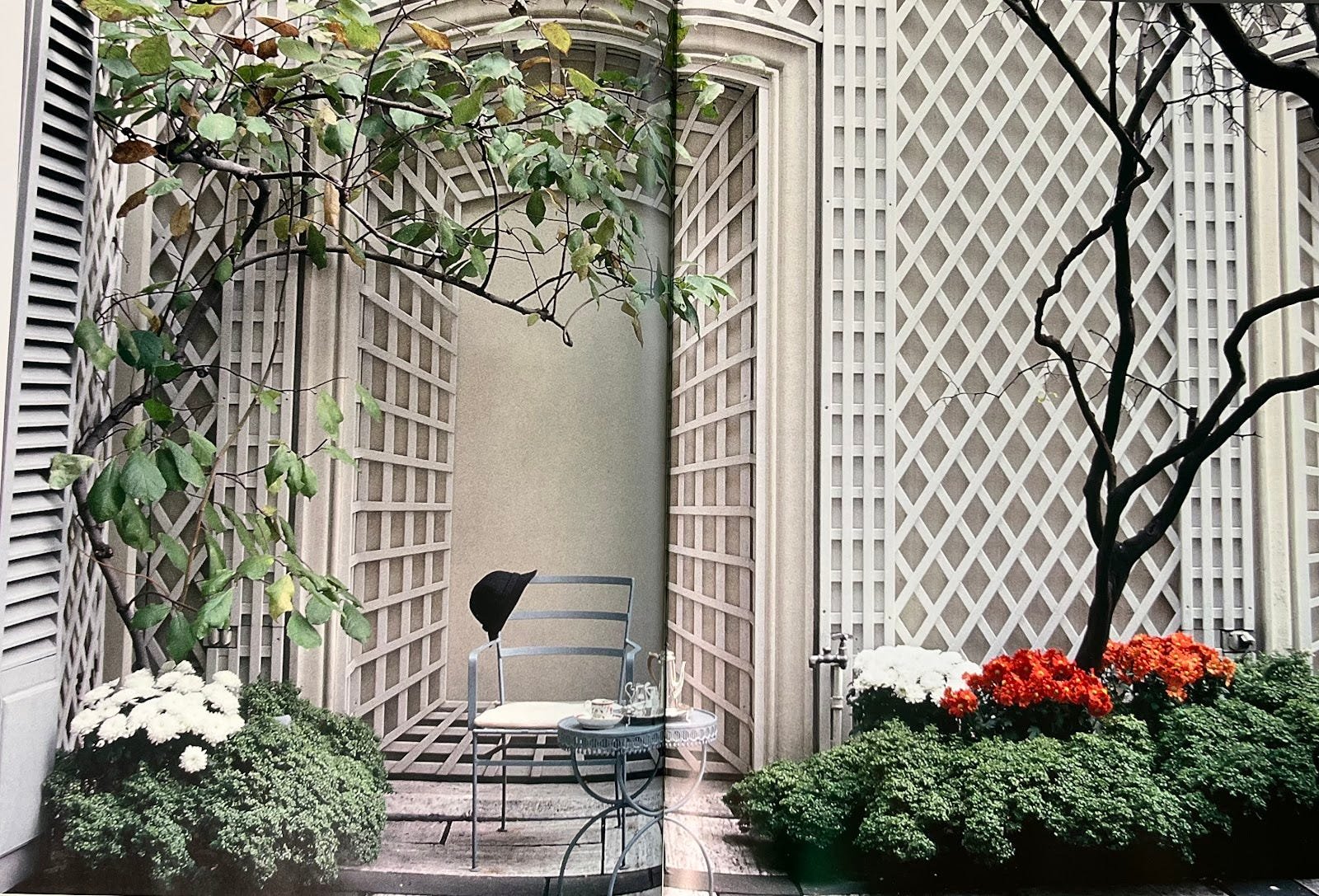#1 Design Solution for an Urban Backyard
Vertical drama seen from the back of your row house will delight you year-round.
London townhouse garden by Alexander Hoyle (source: Elle Decor)
Dear Avant Gardener, I bought an 1800's row house with a very small backyard which is mostly brick, several dogs, and admonishments from the inspector not to plant anything along the edge of the building to avoid drawing water to old bricks and mortar. Regarding the four walls: the house, of course; the wall along the alley is literally falling down wood; a not great brick wall; and a cinderblock wall. We've been wondering about a wall garden. Is that even possible in the mid-Atlantic’s cold weather? — Plantless in Philly
Setting the scene vertically is indeed the design solution for a small, urban, courtyard garden. Fortunately, given your old masonry, the most important place for greenery and drama is opposite the house. Your goal will be to create views from inside that delight and draw you outside year-round. I recommend a combination of wall treatments, furniture, and native climbing vines and evergreen shrubs to enchant through the seasons. Think Charleston or London, embrace the brick, and lean into the symmetry of 19th century architecture.
Secret = restorative
An enclosed city garden starts with the #1 design attribute for a restorative landscape: a feeling of security, of being encapsulated — at least, after you shore up that falling-down wall. If you have the budget, replace it with brick or cinder block to keep down the number of hardscape materials. And stucco all your cinderblock in white or natural cement.
As for green walls, they seem an unnecessarily troublesome and expensive way to achieve vertical interest. Because of the difficulty of insulating roots, many cold-climate living walls are left empty in winter; plants can die not only from freezing, but from lack of water if they come out of dormancy during warm spells when irrigation is off, according to Lori May of Live Wall. And living walls require regular maintenance, usually by landscaping pros, to swap out plants, replace failing pouches or substrate, and tinker with the irrigation system.
Lush woodland-inspired plants
If you have enough space, remove two to six feet of brick paving along the back wall and install your main plantings there. Otherwise, use containers — a single large Victorian cast iron one in the center or clusters of three large containers of various sizes on either side, for example. Keep in mind that, like living walls, planters often fail; keep the size large and the number small until you learn how much you enjoy maintaining them. (I don’t.)
Urban backyards are often shady, so pick woodland plants native to Pennsylvania. The eight below include two beautiful vines to cover your walls — Virginia creeper and virgin’s bower — and two evergreen shrubs for winter interest. The palette channels Vita Sackville-West white garden, with a pop of purple. You can add shade-tolerant flowering shrubs and perennials in this palette if you have room and inclination.
About the dogs: Dogs don’t generally eat the many common garden plants that are poisonous if ingested. However, when enclosed in a small area without supervision, they may get bored and chew the greenery — and anything else around. If your dogs do this, check the ASPCA Toxic Plant List before installing plants.
Set the scene
Thinking theatrically, integrate these plants into a scene of large-scale, all-season decorative elements like trellis, furniture, sculpture, and wall art. Bunny Mellon created an alluring courtyard with just white-on-white trompe l’oeil trellis, a French café table and chair, and a little greenery. You can do a lot with pressure-treated wood trellis panels from Lowe’s or Home Depot. I’m using square trellis to create a faux-front to my Florida home and diamond trellis to create a Mellon-inspired dining porch in Rhode Island.
If your yard is deep enough, add additional furniture and containers or small planting beds along the sides. Tuck your grill and maybe a doggie sandbox along the back of the house so you look over, not at, them from the house.
— The Avant Gardener
Why, How, Wow!
Why — or why not
Eeeeeeeek!🐀 Resist the temptation to plant English ivy. It’s such a popular choice for year-round greenery in brick courtyard gardens I couldn’t avoid it in my inspo images. However, this listed invasive plant attracts and harbors (also invasive) rats — a major problem in Philly. I will never forget the nightly horror of rats running in and out of our Manhattan neighbor’s ivy planters.
Source: The Press Democrat
How
These woodland plants for a Mid-Atlantic row house garden are all available near Philly at Edge of the Woods Native Plant Nursery. (Nursery sales manager Brian Hoffman says if one is out of stock, ask them to save it for you next season.) See “Related Resources” below for how to identify and buy natives for your region.
Wow!
Love the structure, not the exotic plants: Trellis, furniture, sculpture, mirrors, planters, plates, vines, and tree trunks set the scene in these small courtyard gardens. Tip: Choose chairs, benches or lounges you can enjoy without cushions. Cushions are difficult to maintain in harsh climates, and storing or covering essential cushions discourages use and ruins that all-important view; you can always add cushions or pillows in summer.
New York City courtyard garden (source: Bunny Mellon Style)
Source: Southern Living
London row house garden (source: House and Garden)
Related Resources
Planning a garden? Include as many as possible of Douglas Kent’s 10 design attributes for a restorative landscape.
For more northeast plant ideas, see “Balcony gardens – Natives in pots for urbanites and people on the move.”
To find what vines and shrubs are native elsewhere, use the search function at the Lady Bird Johnson Wildflower Center.
To find local and online sources of native plants, see Audubon’s Plant Finder.







